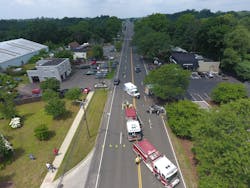In 2016 when the Westport Police Department (Conn.) decided it wanted to purchase an unmanned aircraft system (UAS ), or drone, it looked at a neighboring jurisdiction for guidance and landed upon a DJI Phantom 4. The drone itself is the same model a civilian or hobbyist could purchase, says Captain Ryan Paulsson. “We were able to work within our budget to purchase the drone, and the decision was made at our command level for our emergency services operations,” he says.
The price for the drone, he says, is relatively small for all of its capabilities. Purchased for approximately $1,600, with additional equipment and an iPad for viewing video, GPS and more on the DJI Go app, the total came to about $2,700, not including training and licensing costs.
The features
So far Westport PD is “very happy” with its purchase, says Paulsson, noting that the product has been reliable, with an easy-to-use platform. The Phantom 4 achieves an approximate 28 minute flight time—a 25 percent improvement over its predecessor, the Phantom 3.
The best feature about the drone, in Paulsson’s opinion, is how quickly it can be deployed and how easy it is to use. “It is very forgiving to the novice pilot, and has many built-in safety measures,” he says. “It includes optional settings to restrict certain attributes such as speed, height and distance from PIC, which is handy when training new pilots.” The drone comes with a one-touch button for “return-to-home” and it automatically logs the details of every flight.
“Another nice feature is that if you let go of the control sticks, the drone will stay on station,” says Paulsson. “Using GPS and obstacle avoidance technology, there is less worry of the unit getting away from the pilot, or a loss of control.”
The results
The Westport PD originally wanted the drone to support its dive team operations, to better assist the team in locating submerged objects or victims. “Though our initial intent was for this purpose,” says Paulsson, “we quickly realized its potential for other missions in our department.” The department has expanded its missions from dive operations to accident investigation, documentation of scenes, search and rescue, Public Works projects, pre-event planning and special event monitoring.
One of the first “outside the box” uses of the drone was when the department’s detective bureau was investigating an accidental fall from scaffolding at a local construction site. “Due to the condition of the scaffold, it would be unsafe for our detectives to document any evidence that was there,” says Paulsson. “With the drone, I was able to photograph, with very good detail, the conditions that were present without putting anyone in harm’s way. We are always trying to think of new ways that this technology can benefit us.”
The UAS gives the department increased situational awareness that also allows officers to be placed in strategic locations during special events. “For special events, it is nice having a real world current overview of the venue so I can properly allocate resources for the event,” says Paulsson. “Also, during the event, I can evaluate those positions to see if they need adjustment based on traffic flow, or pedestrian traffic. That was something that would have taken a supervisor time to drive out to each post and evaluate the needs. The drone gives a good overall snapshot in real time of most, if not all, of your venue.”
It also helped capture video and image data on serious and fatal accident scenes, which saved time and resources. “Using the drone, we no longer require the fire department and the large ladder trucks to assist,” Paulsson says. “I can now get photos sooner, so I can show emergency vehicle placement for after action reviews and training purposes. I can get photos while the emergency teams are working. I can see if a fire truck was on top of evidence and other information that wasn’t available before.”
The Westport PD currently has three licensed pilots and one UAS, but is interested in increasing the fleet in the future if budget dollars allow, focusing on a drone with thermal imaging capabilities. “When it comes to drone usage, we are only limited by our imaginations,” says Paulsson.
For other police departments looking at adding UAS technology, Paulsson recommends doing research. “There are a lot of drone products out there,” he says. “Take in as much information as you can, explore your options, and you will find a solution that’s right for you.”
About the Author

Adrienne Zimmer
Editor
Adrienne Zimmer was the Editor of Law Enforcement Technology magazine, a monthly business-to-business publication that covers technology trends and best practices for public safety managers from 2017 to 2019. LET is part of Officer Media Group, which also publishes Law Enforcement Product News and Officer.com. Adrienne has been in publishing since 2013.
